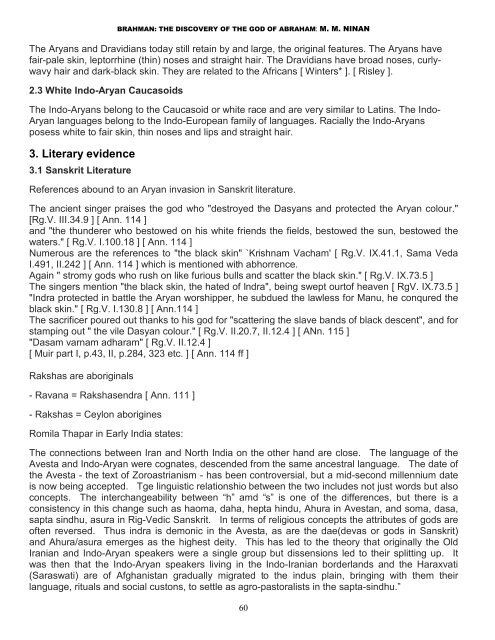Create successful ePaper yourself
Turn your PDF publications into a flip-book with our unique Google optimized e-Paper software.
BRAHMAN: THE DISCOVERY OF THE GOD OF ABRAHAM: M. M. NINAN<br />
The Aryans and Dravidians today still retain by and large, the original features. The Aryans have<br />
fair-pale skin, leptorrhine (thin) noses and straight hair. The Dravidians have broad noses, curlywavy<br />
hair and dark-black skin. They are related to the Africans [ Winters* ]. [ Risley ].<br />
2.3 White Indo-Aryan Caucasoids<br />
The Indo-Aryans belong to the Caucasoid or white race and are very similar to Latins. The Indo-<br />
Aryan languages belong to the Indo-European family of languages. Racially the Indo-Aryans<br />
posess white to fair skin, thin noses and lips and straight hair.<br />
3. Literary evidence<br />
3.1 Sanskrit Literature<br />
References abound to an Aryan invasion in Sanskrit literature.<br />
The ancient singer praises the god who "destroyed the Dasyans and protected the Aryan colour."<br />
[Rg.V. III.34.9 ] [ Ann. 114 ]<br />
and "the thunderer who bestowed on his white friends the fields, bestowed the sun, bestowed the<br />
waters." [ Rg.V. I.100.18 ] [ Ann. 114 ]<br />
Numerous are the references to "the black skin" `Krishnam Vacham' [ Rg.V. IX.41.1, Sama Veda<br />
I.491, II.242 ] [ Ann. 114 ] which is mentioned with abhorrence.<br />
Again " stromy gods who rush on like furious bulls and scatter the black skin." [ Rg.V. IX.73.5 ]<br />
The singers mention "the black skin, the hated of Indra", being swept ourtof heaven [ RgV. IX.73.5 ]<br />
"Indra protected in battle the Aryan worshipper, he subdued the lawless for Manu, he conqured the<br />
black skin." [ Rg.V. I.130.8 ] [ Ann.114 ]<br />
The sacrificer poured out thanks to his god for "scattering the slave bands of black descent", and for<br />
stamping out " the vile Dasyan colour." [ Rg.V. II.20.7, II.12.4 ] [ ANn. 115 ]<br />
"Dasam varnam adharam" [ Rg.V. II.12.4 ]<br />
[ Muir part I, p.43, II, p.284, 323 etc. ] [ Ann. 114 ff ]<br />
Rakshas are aboriginals<br />
- Ravana = Rakshasendra [ Ann. 111 ]<br />
- Rakshas = Ceylon aborigines<br />
Romila Thapar in Early India states:<br />
The connections between Iran and North India on the other hand are close. The language of the<br />
Avesta and Indo-Aryan were cognates, descended from the same ancestral language. The date of<br />
the Avesta - the text of Zoroastrianism - has been controversial, but a mid-second millennium date<br />
is now being accepted. Tge linguistic relationshio between the two includes not just words but also<br />
concepts. The interchangeability between “h” amd “s” is one of the differences, but there is a<br />
consistency in this change such as haoma, daha, hepta hindu, Ahura in Avestan, and soma, dasa,<br />
sapta sindhu, asura in Rig-Vedic Sanskrit. In terms of religious concepts the attributes of gods are<br />
often reversed. Thus indra is demonic in the Avesta, as are the dae(devas or gods in Sanskrit)<br />
and Ahura/asura emerges as the highest deity. This has led to the theory that originally the Old<br />
Iranian and Indo-Aryan speakers were a single group but dissensions led to their splitting up. It<br />
was then that the Indo-Aryan speakers living in the Indo-Iranian borderlands and the Haraxvati<br />
(Saraswati) are of Afghanistan gradually migrated to the indus plain, bringing with them their<br />
language, rituals and social custons, to settle as agro-pastoralists in the sapta-sindhu.”<br />
60


















